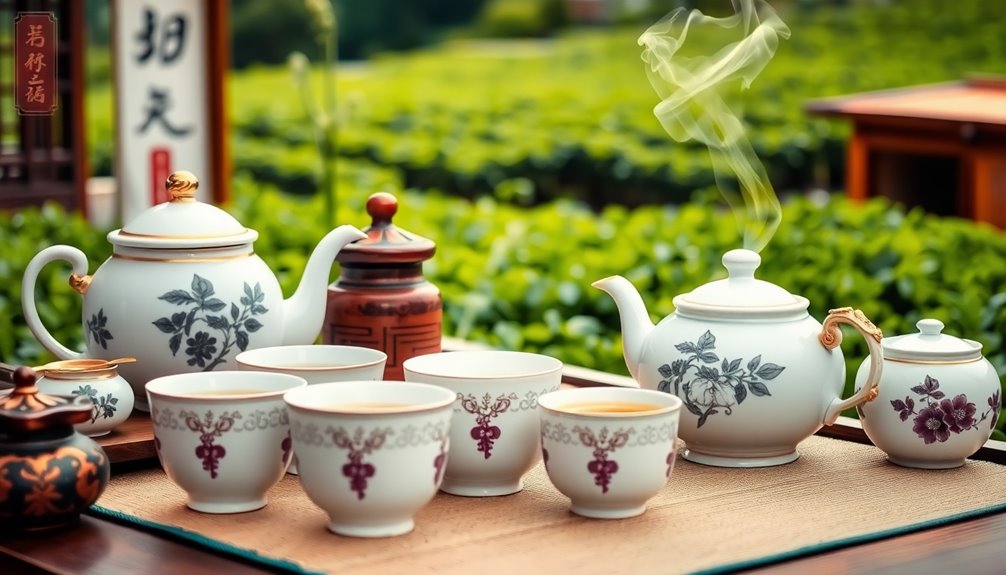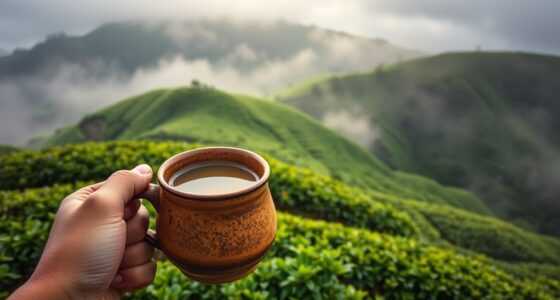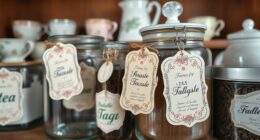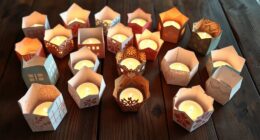Black, green, and white tea all come from the Camellia sinensis plant, but their differences arise from unique processing methods. Black tea undergoes full oxidation, resulting in a bold flavor and higher caffeine content. Green tea experiences minimal oxidation, giving it a lighter taste and lower caffeine. White tea, the least processed of all, is primarily sourced from Fujian Province and has the lowest caffeine level. Historically, tea has played a vital role in cultures worldwide, influencing trade and rituals. To discover the fascinating journey of tea, including its impact on societies, keep exploring this topic.
Key Takeaways
- All tea types, including black, green, and white, originate from the Camellia sinensis plant, differing mainly in processing techniques.
- Black tea undergoes full oxidation, resulting in its robust flavor and higher caffeine content compared to green and white teas.
- Green tea is produced with minimal oxidation, offering a lighter taste and lower caffeine levels, making it distinct from black tea.
- White tea is the least processed, primarily sourced from Fujian Province, and contains the lowest caffeine among the three types.
- The historical significance of tea dates back to ancient China, where it was valued for its medicinal properties and later became a luxury item in Europe.
Introduction

Tea's rich history and diversity make it a fascinating beverage to explore. All black, green, and white teas originate from the Camellia sinensis plant, cultivated for thousands of years, primarily in East Asia. Each tea type undergoes distinct processing methods that significantly influence their flavor, color, and caffeine content.
Black tea experiences full oxidation, resulting in its robust flavor and higher caffeine content, ranging from 40-60 mg per 8 oz cup. In contrast, green tea has minimal oxidation, offering a lighter taste and about 30-35 mg of caffeine. White tea, the least processed, originates mainly from Fujian Province, China, and contains the lowest caffeine content, around 10-15 mg.
The unique characteristics of these teas stem from their origins, with black tea popularized in the 18th century, while green tea has roots in ancient China.
White tea was historically reserved for royalty and served as Tribute Tea. By understanding the differences in processing and their effects on flavor and caffeine content, you can appreciate the complexity and variety that tea offers.
Historical Significance of Tea

Throughout history, the significance of tea extends far beyond its role as a simple beverage. Its origins trace back to ancient China, where it was initially valued for its medicinal properties. The Tang Dynasty (618-907 AD) is crucial in this narrative, as it popularized tea drinking, embedding it deeply within cultural practices and societal rituals.
By the 16th century, tea reached Europe through emerging trade routes, quickly becoming a luxury item enjoyed by the aristocracy. The British East India Company played an essential role in this transformation, especially in exporting black tea, which became a staple of British culture by the 18th century. This shift not only highlighted tea's historical significance but also its economic impact, influencing trade dynamics and colonization efforts.
As tea spread globally, its cultural significance evolved, shaping agricultural practices and local customs. The unique traditional tea ceremony emphasizes mindfulness and respect, showcasing tea's role in social interactions.
Today, black tea, green tea, and white tea each hold unique places in various societies, yet they all share a rich historical tapestry that underscores tea's role in connecting people across civilizations. Understanding this context enhances your appreciation for every sip of tea you enjoy.
Cultural Rituals Surrounding Tea

Embracing the rich traditions surrounding tea, various cultures have developed unique rituals that elevate its consumption into a profound experience.
In Chinese tea culture, the Gongfu tea ceremony emphasizes meticulous preparation and serving techniques, transforming tea enjoyment into an aesthetic and meditative practice.
Meanwhile, in Japan, the Cha-no-yu, or tea ceremony, blends rituals of hospitality with mindfulness, often focusing on matcha, a powdered green tea.
In Britain, afternoon tea has become a cherished ritual since the 19th century, where you enjoy a selection of teas accompanied by finger sandwiches, scones, and pastries, reflecting the social customs of the time.
In India, chai transcends mere beverage status; it's a spiced tea brewed in communal settings, fostering social bonds among family and friends. Additionally, tea can be seen as an integral part of cultural rituals that vary greatly from one region to another, highlighting the diverse ways in which this beverage is appreciated globally.
Tea's Role in Trade History

During the 17th and 18th centuries, tea became a pivotal commodity in global trade, shaping economic and cultural exchanges between continents. Tea's role in trade history is particularly notable, as the British East India Company monopolized imports to Britain, altering tea consumption habits among the British populace.
The demand for black teas, which include varieties like Assam and Darjeeling, significantly influenced the establishment of trade routes connecting Europe, Asia, and the Americas. As tea is processed, its popularity soared, but this led to complications such as the Opium Wars in the mid-19th century.
The British hunger for Chinese tea created a trade imbalance, prompting the controversial opium trade. The introduction of tea in the Americas also sparked significant events, like the Boston Tea Party in 1773, where colonists protested against British taxation and trade practices.
Today, the global tea market is valued at around $200 billion, with green and black teas continuing to dominate international trade. The legacy of tea in trade history is profound, influencing not just economies, but also cultures worldwide.
Health Claims and Regulations

Tea's health claims have gained significant attention, with many studies highlighting its potential benefits, from improving heart health to aiding weight management. These claims often stem from the presence of antioxidants, such as catechins and polyphenols, particularly in green tea.
However, regulatory bodies like the FDA require that any health claims made by tea manufacturers be backed by scientific evidence. This ensures consumer safety and prevents misleading information.
In Europe, the European Food Safety Authority (EFSA) mandates that specific criteria must be met for health claims approval. For instance, a claim stating that "consumption of green tea can help maintain normal blood cholesterol levels" has to fulfill these requirements.
The tea industry is also subject to strict dietary regulations regarding labeling and advertising, ensuring that health benefits are communicated transparently.
Despite ongoing research into the health benefits of tea, it's wise to consult healthcare professionals before relying solely on it for health improvements. Individual results can vary significantly based on your overall diet and lifestyle.
Practical Applications

When you incorporate tea into your daily routine, you can explore a variety of practical applications that enhance both enjoyment and wellness.
Black tea, with its robust flavor and higher caffeine content, is perfect for a morning boost. Try varieties like Assam or Darjeeling to experience their distinct taste profiles.
For a refreshing afternoon pick-me-up, green tea, known for its minimal oxidation and fresh flavor, offers unique flavors like Matcha and Sencha, which can help improve focus and metabolism.
White tea, derived from young buds and minimally processed, provides a delicate flavor and high antioxidant content, making it an excellent choice for evening relaxation.
Understanding the origins and processing methods of these teas not only deepens your appreciation for their unique flavors but also highlights their potential health benefits.
For instance, the varying oxidation levels in black, green, and white tea affect their flavor profiles and health properties. Drinking tea can also support improved heart health through its antioxidant properties.
Enhancing your life with these teas can be as simple as choosing the right one for your mood or health goals, making tea a versatile and enjoyable addition to your daily routine.
Conclusion
In conclusion, understanding the origins of black, green, and white tea enriches your appreciation for this beloved beverage. As you explore its historical significance, cultural rituals, and health benefits, you connect more deeply with your tea-drinking experience. Remember, every sip carries a story of trade, tradition, and wellness. So, whether you prefer a robust black tea or a delicate white, you're not just enjoying a drink—you're participating in a global legacy that spans centuries.










